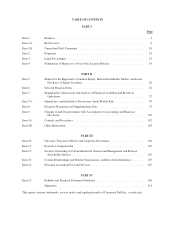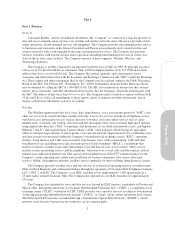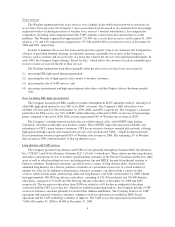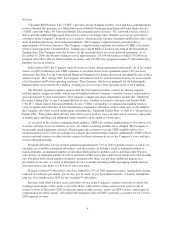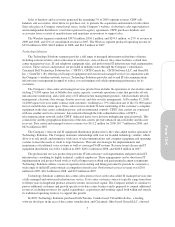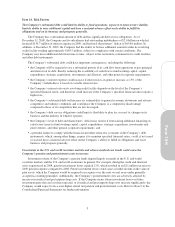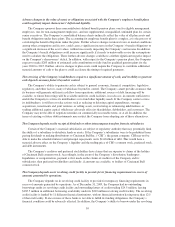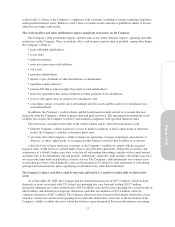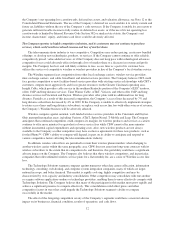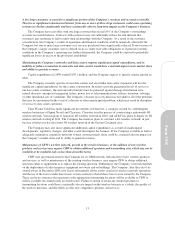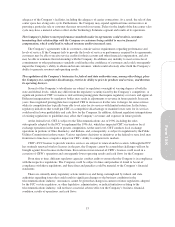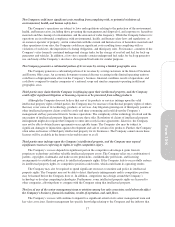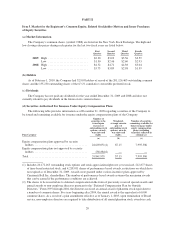Cincinnati Bell 2009 Annual Report Download - page 81
Download and view the complete annual report
Please find page 81 of the 2009 Cincinnati Bell annual report below. You can navigate through the pages in the report by either clicking on the pages listed below, or by using the keyword search tool below to find specific information within the annual report.
credit facility is subject to the Company’s compliance with covenants, including covenants requiring compliance
with specified financial ratios. Failure to satisfy these covenants would constrain or prohibit its ability to borrow
under the revolving credit facility.
The credit facilities and other indebtedness impose significant restrictions on the Company.
The Company’s debt instruments impose, and the terms of any future debt may impose, operating and other
restrictions on the Company. These restrictions affect, and in many respects limit or prohibit, among other things,
the Company’s ability to:
•incur additional indebtedness;
•create liens;
•make investments;
•enter into transactions with affiliates;
•sell assets;
•guarantee indebtedness;
•declare or pay dividends or other distributions to shareholders;
•repurchase equity interests;
•redeem debt that is junior in right of payment to such indebtedness;
•enter into agreements that restrict dividends or other payments from subsidiaries;
•issue or sell capital stock of certain of its subsidiaries; and
•consolidate, merge, or transfer all or substantially all of its assets and the assets of its subsidiaries on a
consolidated basis.
In addition, the Company’s credit facilities and debt instruments include restrictive covenants that may
materially limit the Company’s ability to prepay debt and preferred stock. The agreements governing the credit
facilities also require the Company to achieve and maintain compliance with specified financial ratios.
The restrictions contained in the terms of the credit facilities and its other debt instruments could:
•limit the Company’s ability to plan for or react to market conditions or meet capital needs or otherwise
restrict the Company’s activities or business plans; and
•adversely affect the Company’s ability to finance its operations, strategic acquisitions, investments or
alliances, or other capital needs, or to engage in other business activities that would be in its interest.
A breach of any of these restrictive covenants or the Company’s inability to comply with the required
financial ratios would result in a default under some or all of the debt agreements. During the occurrence and
continuance of a default, lenders may elect to declare all outstanding borrowings, together with accrued interest
and other fees, to be immediately due and payable. Additionally, under the credit facilities, the lenders may elect
not to provide loans until such default is cured or waived. The Company’s debt instruments also contain cross-
acceleration provisions, which generally cause each instrument to be subject to early repayment of outstanding
principal and related interest upon a qualifying acceleration of any other debt instrument.
The Company’s future cash flows could be adversely affected if it is unable to realize fully its deferred tax
assets.
As of December 31, 2009, the Company had net deferred income taxes of $477.5 million, which includes
deferred tax assets associated with U.S. federal net operating loss carryforwards totaling $393.7 million,
alternative minimum tax credit carryforwards of $14.4 million, state and local net operating loss carryforwards of
$60.6 million, and deferred tax temporary differences and other tax attributes of $76.0 million, offset by
valuation allowances of $67.2 million. The valuation allowances have been provided against deferred tax assets
related to certain state and local net operating losses and other deferred tax assets due to the uncertainty of the
Company’s ability to utilize the assets within the statutory expiration period. For more information concerning
11
Form 10-K



